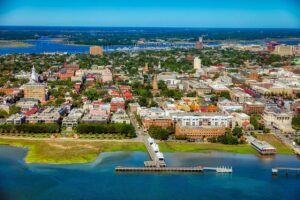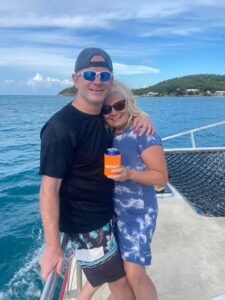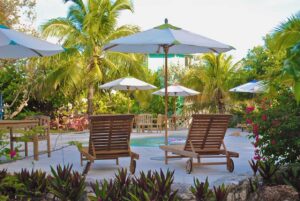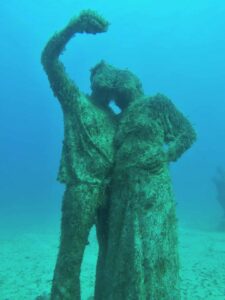AFTER 10 YEARS OF planning and preparing for the adventure of a lifetime, we cast off from San Francisco aboard our 33-foot sailboat named Chewbacca. Our crew consisted of me, my husband Bruce, and our five and seven-year-old daughters. When we embarked on our first offshore passage as a family, I should have been giddy with excitement, but instead I was smothered by one of my biggest fears — belly-flopping at homeschool.
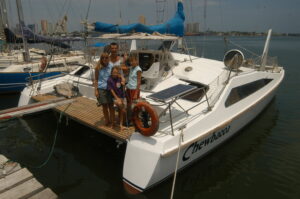
Worries about my teaching skills were keeping me awake at night. What if Kendall and Quincy were grade levels behind when we returned to the United States? What if they couldn’t make friends and were known as those “super- weird boat kids” as a result of our rogue choices? Self-doubt crept into my consciousness and ate away at my dreams of being an exemplary teacher with two enthusiastic scholars.
I tried my best, but the girls weren’t excited about me in the role of teacher, and they were staging an all-out revolt. My students were uncooperative and didn’t complete their assignments with the gusto I had envisioned. Just how did Mary Poppins do it?
Sailing down the Mexican coast I had heard of a popular destination for “kid boats” where I hoped to meet other homeschooling moms and learn how they mastered their teaching afloat.
When we arrived, I took Chewbacca for a spin around the crowded anchorage searching for a good place to drop anchor. I counted 45 boats and not long after we set the anchor, the VHF radio chirped to life.
“Chewbacca, Chewbacca, Chewbacca, this is Rebel, over,” hailed a friendly female voice. “Rebel let’s go seven-two” I replied and switched channels. “Hello Chewbacca, this is Kimberly, welcome to our little slice of paradise! We heard you are a kid boat, and so are we. School’s out at 2 o’clock, come join us on the beach.” “Kimberly, April here. I look forward to meeting you. Chewbacca switching back to one-six,” and with that, a smile stretched across my face. Little did I know we had just put down roots in Homeschool Central.
Sure enough, at 2:00 p.m. sharp, the tranquil anchorage burst to life with the sounds of dinghies zooming to shore, followed closely by surfboards, boogie boards, kayaks and rowboats. We trailed the surge.
It was a cruising kid’s fantasyland. A dozen little people with pint-sized pails and shovels in hand, set about digging motes and building sandcastles. Another dozen frolicked in the surf while a few teenagers commandeered the beach to launch homemade kites.
Help on the Horizon
We merged with the group of parents to introduce ourselves. I was anxious to discuss the subject of school with other moms and was relieved to hear that EVERYONE had rocky patches, and I was not alone in doubting my capabilities as a teacher. Just like me, no one had homeschooled their kids before.
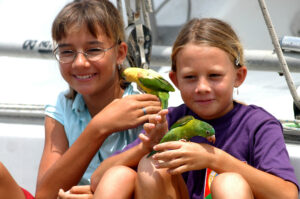
We were all grappling with our new roles of captain and first mate, mastering the skills that long-distance sailing required, and settling into a new lifestyle set in foreign lands. The scope of the changes in our new lives overwhelmed most of us. When children were added to the mix, it upped the ante to the stratosphere. We all had a healthy level of concern about our kids’ education, and it turned out we had all asked ourselves the same question at some point. Was it fair to take our kids on this adventure?
Some critics back home declared that taking children away from our culture and formal education would result in them not being able to compete in our modern society. They would be stunted intellectually and socially if we carted them off outside the conventional norms. Would they be proved right?
I needed to set our girls up for success, and meeting new friends in the same situation proved we were not alone in our schooling quandary. Yet, everyone agreed that with a little creativity and consistency, success was achievable.
We batted around solutions to our thorniest problems of keeping our kids on track and excited about their studies. This was no easy feat when enticing new countries and cultures lay just outside the classroom walls where it would be so easy to forget school for one day … and then another day and another, rather than buckling down and staying on target.
As the sun set, we had exhausted the topic of schooling for one day. Our little band broke up, and we dispersed back to our floating homes. Armed with fresh knowledge and new strategies, Bruce and I began to plan the next week of school and added new twists to our lessons. We adopted guidelines for school hours, daily reading, writing and math work. We had a plan, and I was feeling empowered.
Early the next day, Kendall and Quincy were chatting animatedly about playing with their friends. They were shocked when I told them it was a school day, and we had lessons planned. I guess the other kids forgot to tell them how school time worked in this anchorage. Until 2:00 p.m., school was in session for all the kids. After homeschool was completed, they could play on the beach to their heart’s content.
From that day forward, Chewbacca’s crew came to terms with a new format of homeschool while afloat, and we hit upon a comfortable, successful groove while adhering to a few cardinal rules:
- School was consistent, five days a week.
- If we were exploring somewhere new, history, science, English, social studies and math lessons were tailored to take in our new surroundings.
- If we were passage-making, we studied sailing, nature, weather and the world around us, not bookwork.
- We spent the first day in a new country completing official business and getting our bearings, then we resumed the school routine.
- The “school year” was finished when the subject lessons were completed. That might take six months, nine months or a year.
We also added a team element to homeschool:
- Bruce acquired the title of Professor of Mathematics and Music, while I commanded English, history and social studies.
- With the girls’ input, we designed a flag to raise when school was in session aboard Chewbacca. Much like a DO NOT DISTURB sign on a hotel doorknob, it signaled to our boat friends that we were busy in class.
It didn’t take long to realize that travel lends itself well to homeschooling as the natural world unfolded before our eyes and ancient cultures sprung to life. As Hurricane Juliette bore down on us in Mexico, we turned the situation into a teachable one. To keep the girls’ minds off the ever-strengthening wind, homeschool was in full session. Each day they charted Juliette’s progress toward us and colored in tightly wound swirls on construction paper. Bruce threw in a few word problems, and they practiced with dividers and geometry tools of the trade.

As the girls scampered up the 2,000-year-old steps of a Mayan pyramid, Bruce and I followed, each step upward taking us back in time. As our family gathered at the top to survey the rainforest below, ancient stone monuments poked through the jungle canopy, and archeology and history leapt to life.
Homeschooling math on a boat always led away from theory and focused on real life applications. Living for months at anchor was another opportunity to incorporate school into daily life. Venturing off the beaten path in the San Blas Islands of Panama for four months meant careful provisioning. I constructed a menu by listing our typical canned meals and guessing how many times a week we could stomach them. The girls worked the numbers and came up with 120 lunches, 120 snacks and 120 dinners, which translated to 1,540 plates, 1,540 assorted bowls, 720 pots and 4,320 utensils they must wash, dry and put away.
After about a year we settled into our new lifestyle, successfully hit our home-schooling stride, and I finally found peace with my role as mother and teacher. For the next 10 years, we kept to the same school routine and teaching partnership we learned while anchored at Homeschool Central. Kendall and Quincy both went on to graduate with honors from university.
April Winship won 1st Place accolades in Marinalife’s 20th Anniversary Boating Story Contest. The award-winning article that tells the tale of her family’s epic journey appeared in Marinalife’s Spring 2020 issue.


